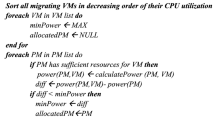Abstract
Cloud computing has evolved as the next-generation platform for hosting applications ranging from engineering to sciences, and from social networking to media content delivery. The numerous data centers, employed to provide cloud services, consume large amounts of electrical power, both for their functioning and their cooling. Improving power efficiency, that is, decreasing the total power consumed, has become an increasingly important task for many data centers for reasons such as cost, infrastructural limits, and mitigating negative environmental impact. Power management is a challenging optimization problem due to the scale of modern data centers. Most published work focuses on power management in computing nodes and the cooling facility in an isolated manner. In this paper, we use a combination of server consolidation and thermal management to optimize the total power consumed by the computing nodes and the cooling facility. We describe the engineering of an evolutionary non-deterministic iterative heuristic known as simulated evolution to find the best location for each virtual machine (VM) in a data center based on computational power and data center heat recirculation model to optimize total power consumption. A “goodness” function which is related to the target objectives of the problem is defined. It guides the moves and helps traverse the search space using artificial intelligence. In the process of evolution, VMs with high goodness value have a smaller probability of getting perturbed, while those with lower goodness value may be reallocated via a compound move. Results are compared with those published in previous studies, and it is found that the proposed approach is efficient both in terms of solution quality and computational time.















Similar content being viewed by others
References
Ajiro Y, Tanaka A (2007) Improving packing algorithms for server consolidation. In: International of CMG conference, pp 399–406
Al-Qawasmeh AM, Pasricha S, Maciejewski A, Siegel HJ et al (2015) Power and thermal-aware workload allocation in heterogeneous data centers. IEEE Trans Comput 64(2):477–491
Barham P, Dragovic B, Fraser K, Hand S, Harris T, Ho A, Neugebauer R, Pratt I, Warfield A (2003) Xen and the art of virtualization. ACM SIGOPS Oper Syst Rev 37(5):164–177
Barroso LA, Hölzle U (2007) The case for energy-proportional computing. IEEE Comput 40(12):33–37
Basmadjian R, Niedermeier F, De Meer H (2012) Modelling and analysing the power consumption of idle servers. In: Sustainable internet and ICT for sustainability (SustainIT). IEEE, pp 1–9
Bohrer P, Elnozahy EN, Keller T, Kistler M, Lefurgy C, McDowell C, Rajamony R (2002) The case for power management in web servers. In: Power aware computing. Springer, Berlin, pp 261–289
Brown DJ, Reams C (2010) Toward energy-efficient computing. Commun ACM 53(3):50–58
Chase JS, Anderson DC, Thakar PN, Vahdat AM, Doyle RP (2001) Managing energy and server resources in hosting centers. In: ACM SIGOPS operating systems review, vol 35. ACM, pp 103–116
Doddavula SK, Kaushik M, Jain A (2011) Implementation of a fast vector packing algorithm and its application for server consolidation. In: IEEE third international conference on cloud computing technology and science (CloudCom). IEEE, pp 332–339
Fan X, Weber WD, Barroso LA (2007) Power provisioning for a warehouse-sized computer. In: ACM SIGARCH Computer Architecture News, vol 35. ACM, pp 13–23
Feng X, Ge R, Cameron KW (2005) Power and energy profiling of scientific applications on distributed systems. In: Parallel and distributed processing symposium, proceedings. 19th IEEE International. IEEE, pp 34–34
Filani D, He J, Gao S, Rajappa M, Kumar A, Shah P, Nagappan R (2008) Dynamic data center power management: trends, issues, and solutions. Intel Technol J 12(1):59–67
Fu Y, Lu C, Wang H (2010) Robust control-theoretic thermal balancing for server clusters. In: IEEE international symposium on parallel & distributed processing (IPDPS). IEEE, pp 1–11
Gao Y, Guan H, Qi Z, Hou Y, Liu L (2013) A multi-objective ant colony system algorithm for virtual machine placement in cloud computing. J Comput Syst Sci 79(8):1230–1242
Glover F (1989) Tabu search-part I. ORSA J Comput 1(3):190–206
Glover F (1990) Tabu search-part II. ORSA J Comput 2(1):4–32
Hamilton J (2009) Cooperative expendable micro-slice servers (CEMS): low cost, low power servers for internet-scale services. In: Conference on innovative data systems research (CIDR)
Hartmann AK, Weigt M (2006) Phase transitions in combinatorial optimization problems: basics, algorithms and statistical mechanics. Wiley, New York
Helion Eucalyptus Docs Team (2015) Eucalyptus Scheduling Policies. https://www.eucalyptus.com/docs/eucalyptus/4.0.2/install-guide/sched_pol.html. Accessed 5 Nov 2015
Ingber L (1993) Simulated annealing: practice versus theory. Math Comput Model 18(11):29–57
Kennedy J (1997) The particle swarm: social adaptation of knowledge. In: Evolutionary computation. IEEE International conference on. IEEE, pp 303–308
Khan JA, Sait SM, Minhas MR (2002) Fuzzy biasless simulated evolution for multiobjective vlsi placement. In: Evolutionary computation. CEC’02. Proceedings of the 2002 congress on, vol 2. IEEE, pp 1642–1647
Kling RM, Banerjee P (1987) Esp: a new standard cell placement package using simulated evolution. In: Proceedings of the 24th ACM/IEEE design automation conference. ACM, pp 60–66
Kramer HH, Petrucci V, Subramanian A, Uchoa E (2012) A column generation approach for power-aware optimization of virtualized heterogeneous server clusters. Comput Ind Eng 63(3):652–662
Moore JD, Chase JS, Ranganathan P, Sharma RK (2005) Making scheduling “cool”: temperature-aware workload placement in data centers. In: USENIX annual technical conference, General Track, pp 61–75
Mukherjee T, Tang Q, Ziesman C, Gupta SK, Cayton P (2007) Software architecture for dynamic thermal management in datacenters. In: 2nd International conference on communication systems software and middleware. IEEE, pp 1–11
Nahar S, Sahni S, Shragowitz E (1989) Simulated annealing and combinatorial optimization. Int J Comput-Aid VLSI Des 1(1):1–23
OpenNebula (2015) OpenNebula Scheduling Policies. http://archives.opennebula.org/documentation:rel4.4:schg. Accessed 5 Nov 2015
Patel CD, Bash CE, Sharma R, Beitelmal M, Friedrich R (2003) Smart cooling of data centers. In: ASME 2003 international electronic packaging technical conference and exhibition. American Society of Mechanical Engineers, pp 129–137
Pinheiro E, Bianchini R, Carrera EV, Heath T (2001) Load balancing and unbalancing for power and performance in cluster-based systems. In: Workshop on compilers and operating systems for low power, vol 180. Barcelona, pp 182–195
Sait SM, Bala A, El-Maleh AH (2016) Cuckoo search based resource optimization of datacenters. Appl Intell. doi:10.1007/s10489-015-0710-x
Sait SM, Shahid KS (2015) Engineering simulated evolution for virtual machine assignment problem. Appl Intell 43(2):1–12
Sait SM, Youssef H (1994) VLSI physical design automation: theory and practice. McGraw-Hill Inc, New York
Sait SM, Youssef H (1999) Iterative computer algorithms with applications in engineering: solving combinatorial optimization problems. IEEE Computer Society Press, Los Alamitos, CA, USA
Sullivan RF (2000) Alternating cold and hot aisles provides more reliable cooling for server farms. Uptime Institute, Santa Fe, New Mexico
Systems IT Governance Research Team (2008) In: Green IT: reality, benefits and best practices. IT Governance, Ely,UK
Tang Q, Gupta SK, Varsamopoulos G (2008) Energy-efficient thermal-aware task scheduling for homogeneous high-performance computing data centers: a cyber-physical approach. IEEE Trans Parallel Distrib Syst 19(11):1458–1472
Tang Q, Mukherjee T, Gupta SK, Cayton P (2006) Sensor-based fast thermal evaluation model for energy efficient high-performance datacenters. In: Fourth international conference on intelligent sensing and information processing (ICISIP). IEEE, pp 203–208
The Climate Group on behalf of the Global eSustainability Initiative (GeSI) (2008) SMART 2020: enabling the low carbon economy in the information age. Climate Group
Wang L, von Laszewski G, Dayal J, Furlani TR (2009) Thermal aware workload scheduling with backfilling for green data centers. In: Performance computing and communications conference (IPCCC), IEEE 28th International. IEEE, pp 289–296
Wang X, Wang Y, Cui Y (2016) An energy-aware bi-level optimization model for multi-job scheduling problems under cloud computing. Soft Comput 20(1):303–317
Xu B, Peng Z, Xiao F, Gates AM, Yu JP (2015) Dynamic deployment of virtual machines in cloud computing using multi-objective optimization. Soft Comput 19(8):2265–2273
Youssef H, Sait SM, Khan SA (2002) Topology design of switched enterprise networks using a fuzzy simulated evolution algorithm. Eng Appl Artif Intell 15(3):327–340
Zheng F, Zecchin AC, Simpson AR (2015) Investigating the run-time searching behavior of the differential evolution algorithm applied to water distribution system optimization. Environ Model Softw 69:292–307
Acknowledgements
The authors acknowledge King Fahd University of Petroleum and Minerals (KFUPM) for all support. The work was conducted as part of project COE-572132-2.
Author information
Authors and Affiliations
Corresponding author
Ethics declarations
Conflict of interest
The authors declare that they have no conflict of interest.
Additional information
Communicated by V. Loia.
Rights and permissions
About this article
Cite this article
Sait, S.M., Raza, A. Engineering simulated evolution for integrated power optimization in data centers. Soft Comput 22, 3033–3048 (2018). https://doi.org/10.1007/s00500-017-2556-0
Published:
Issue Date:
DOI: https://doi.org/10.1007/s00500-017-2556-0




